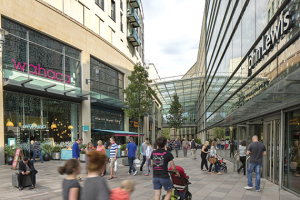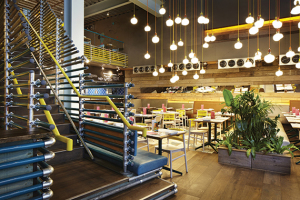 Cardiff has seen a wave of new restaurants open their doors in the past 12 months. High-profile new entrants include US burger brand Five Guys, Mexican restaurant Wahaca, Burger & Lobster and Bill’s, each attracted to what has become one of the UK’s most sought-after leisure locations.
Cardiff has seen a wave of new restaurants open their doors in the past 12 months. High-profile new entrants include US burger brand Five Guys, Mexican restaurant Wahaca, Burger & Lobster and Bill’s, each attracted to what has become one of the UK’s most sought-after leisure locations.
“Cardiff is a year-round, event-led, leisure destination and restaurateurs are finally cottoning on to what it can offer them,” says Christie & Co’s John Coggins. “The city is seventh in the AlixPartners Market Growth Monitor and there have been 10 new restaurants opening [there] in the past year alone.”
It is little wonder when you look at the credentials of the vibrant, compact city with a strong demographic, large student population and of course the Millennium Stadium, which gets 1.3m visitors a year.
Added to that, many restaurateurs have been lured by leisure opportunities within the £675m extension of the St David’s shopping centre.
The centre, developed through a joint venture between Land Securities and intu, opened in 2009 and is now home to 35 restaurants. In the past year alone it has seen openings by Barburrito, which has made its first foray into Wales, together with Shake Shack and Wahaca, both of which have chosen Cardiff as their first venture outside London.
Cushman & Wakefield’s Thomas Rose is one of St David’s letting agents. He says: “We have a list of 15 to 20 London operators keen to get in. It may be that we can find space for one or two more, but it’s impossible to accommodate all the demand.”
Beyond the shopping centre, recent demand from the restaurant sector has extended the city’s traditional leisure pitch and a shortage of suitable prime units has forced operators to widen their search.
St David’s has helped develop a strong offer around The Hayes and Mill Lane, yet as demand increases, operators are also investigating opportunities in the likes of Bridge Street, where Stable Pizza is about to open, and St Mary Street, which in the past few months has welcomed the likes of Grazing Shed and Turtle Bay.
“We’ve got more than 60 operators looking for space in the city and the list keeps getting longer,” says EJ Hales partner Phil Morris. “Investments such as the Millennium Stadium and St David’s have really changed perceptions of Cardiff and it is now becoming difficult to find suitable space.”
The presumption of non-consent has made it tougher for operators to use existing retail units. Some have managed to win over the planners – such as steakhouse Miller & Carter, which has converted the old Habitat unit on The Hayes.
Others have turned their attention to supplanting existing operators. According to EJ Hales, a growing number are getting out their cheque books to persuade other restaurateurs to sell their leases. French restaurant operator Côte, for example, is rumoured to have paid a significant premium to Kapu Lounge for its unit on Mill Lane.
Cardiff is now the only location outside London with two Côte restaurants, the first of which is situated on Cardiff Bay’s Mermaid Quay.
Cardiff Bay remains a key target for restaurant groups. The appeal of combining city centre and waterfront dining has led to a number of restaurateurs doubling up in the city, including the likes of Carluccio’s, Bill’s and Las Iguanas.
“Everyone has been wondering when demand for restaurants in Cardiff is going to run out, but it just keeps going,” says Fleurets’ Kevin Conibear. “Many London operators are now putting Cardiff ahead of Bristol and it is ranked with other cities such as Manchester and Birmingham when they are looking at their first wave of expansion.”
Conibear believes there is still scope for yet more restaurants in the city centre and says a number of emerging London brands are undertaking feasibility studies.
Time will tell what impact the supply-and-demand scenario will have on rents. “Rents have moved from the mid £20s per sq ft before the St David’s extension to the late £30s per sq ft,” Conibear says.
Within St David’s itself, intu confirms that recent restaurant deals have pushed rents above £50 per sq ft and Cushman & Wakefield’s Rose believes that, with demand at the level it is, there could be scope for yet further growth.
“In terms of affordability we may see them start to level out,” says Conibear, “but if you have a rapidly expanding brand, especially one backed by private equity, they will be determined to get the unit they want, one way or another.”
That insatiable appetite is set to benefit other locations across South Wales. “Cardiff is a no brainer, but other cities along the M4 are also likely to appeal as demand creates a ripple effect,” says GVA’s Peter Constantine.
The next obvious stepping stone for restaurant brands is, of course, Swansea and the city is finally starting to progress from what has been a relatively low base.
Las Iguanas and Five Guys have recently committed to Swansea city centre, while the waterfront Oyster Wharf scheme in Mumbles has attracted Loungers, Prezzo and Le Bistrot Pierre. Key regeneration projects such as the creation of a new £100m Swansea University campus at SA1 will further boost the city’s leisure credentials.
Meanwhile, the restaurant scene in Newport has received a considerable shot in the arm from Queensberry Real Estate, which will open its 390,000 sq ft Friars Walk shopping centre next month (see p100). For years Newport was not even on the map for leisure operators and the only restaurant operating in the city centre was McDonald’s.
Yet Friars Walk has so far attracted a comprehensive restaurant line-up, including Nando’s, Loungers, Wagamama, Chiquito and Le Bistrot Pierre.
GVA’s Tom Merrifield says: “The line-up is mass market and we haven’t yet seen the likes of Bill’s and Côte, but if the trading environment is right then others will follow. You only have to look at Cardiff and St David’s to see what impact a new shopping centre can have on attracting restaurateurs.”
How Wahaca came to Cardiff
Mexican restaurant operator Wahaca chose Cardiff for its first venture outside London. A year after opening, co-founder Mark Selby insists the gamble has paid off.
Wahaca has built an impressive London portfolio of 18 restaurants. It was no surprise its founders wanted to embark on expansion into the regions, but the choice of Cardiff for the first port of call would have surprised many.
 “We certainly raised a few eyebrows when we decided to make the move,” says Selby.
“We certainly raised a few eyebrows when we decided to make the move,” says Selby.
“We were very nervous about going out of London and nowhere else we had toyed with in the past had seemed quite right. Then one day someone set up a Wahaca for Cardiff Twitter campaign and a contact, who has since become our general manager, showed us around the city.”
Selby researched the market but admits the decision to open a 5,600 sq ft bar and restaurant within St David’s was largely down to gut feeling.
He says: “Cardiff has gained a reputation for its foodie scene and we could see nobody else was doing anything quite like we do. Trade has been brilliant. It is a vibrant, growing city and it is no surprise restaurateurs are finally starting to take notice.”











